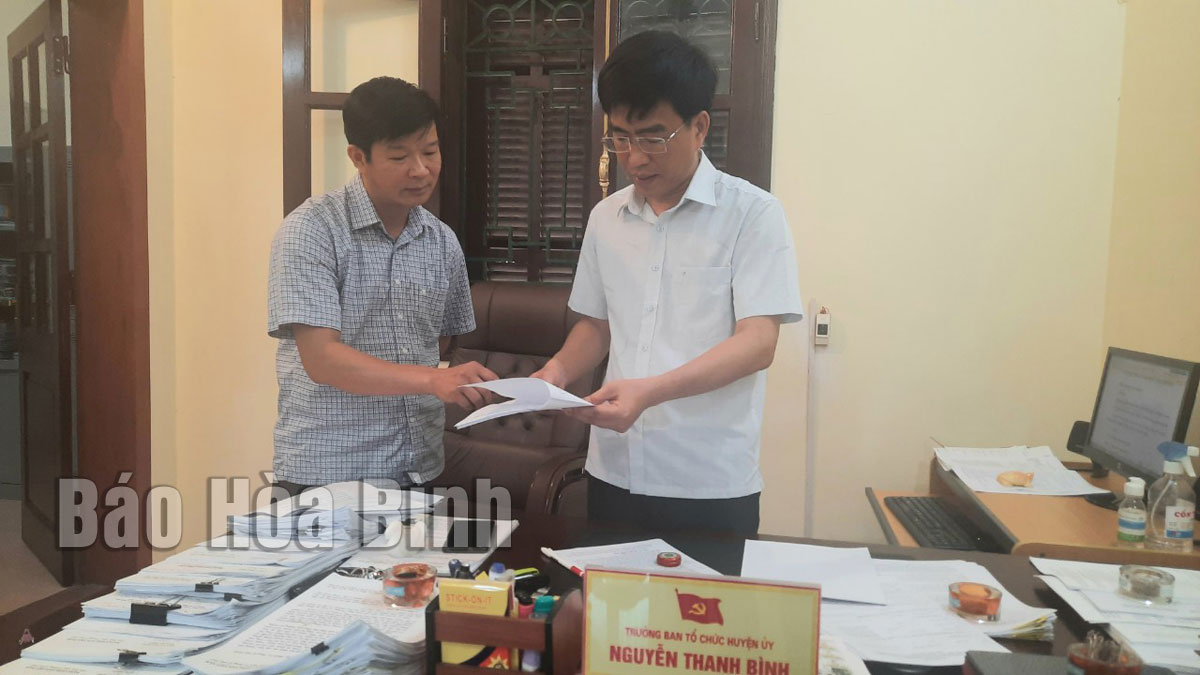
(HBO) – The serious implementation of Resolution No. 04-NQ/TW of the 12th Party Central Committee in Cao Phong district has helped create clear changes in the awareness and actions of cadres and party members, according to Nguyen Thanh Binh, head of the organisation board of the Cao Phong district Party Committee. Binh said, the leadership capacity and fighting strength of Party organisations and Party members in the district have been strengthened, contributing to the district's success in performing the set tasks.

Leaders of the Cao Phong district Party Committee’s organization board
evaluate the quality of Party cells, officials and Party members of the
district Party organisation.
The Party organisation of Cao Phong district has 27 member Party organisations,
including 16 grassroots Party organisations. In recent years, the district
Party Committee has developed action plans to implement the Resolution.
Special attention has been paid to evaluating and classifying member Party
organisations and Party members, officials and collectives at all levels in
association with the self-criticism and criticism work in line with the
Resolution.
The quality of grassroots Party committees has basically met the set tasks. The
quality of Party cells’ activities has been improved with many changes in the
2016-2020. No Party grassroots organisations under the district Party Committee
failed to complete the task.
Closely following the direction of the Party Committee at higher levels, the
Party Committee of Tay Phong commune built and implemented specific action
plans for the implementation of the Resolution.
Secretary of the communal Party Committee Bui Van Ngoi said the serious
implementation of the Resolution has helped create a clear change in Party
building, and criticism, self-criticism, inspection and supervision.
The communal Party Committee has completed the task of enhanced newly-rural
area building. It is working hard on building model newly-rural areas. The per
capita income reaches 47 million VND per year.
In the spirit of "Party members go first, the people follow”, all households of Party members in the Doan Ket sub-region in Da Bac town, Da Bac district, voluntarily removed gates and fences, and donated land when the road expansion project passed through their properties. Inspired by their example, 68 households in the sub-region quickly followed suit, contributing over 1,400 sq.m of residential and perennial cropland to widen the main road through the residential area. The exemplary role of Party members in Doan Ket stands as a shining example of studying and following President Ho Chi Minh’s thought, morality, and lifestyle.
The Hoa Binh provincial People's Committee held a monthly meeting on May 29 to assess the implementation of socio-economic development tasks in the first six months of 2025, the progress of key projects, and some other important issues.
During his lifetime, President Ho Chi Minh always expressed his deep affection and special concern for children and youth. He once emphasized: "Caring for and educating children well is the responsibility of the entire Party and the entire people”; "First of all, the family (i.e. grandparents, parents, siblings) must do this job well”. "the Party Committees…, the Children’s Committee, the Youth Union, the education sector, and all related organizations must have specific plans to ensure children grow healthier and more progressive”. His teachings has been remaining valuable and serving as the guiding principles in the work of protecting, caring for, and educating children. In line with this ideology, Hoa Binh Province has continuously been prioritizing and investing resources in the well-being of children in recent years.
Mr. Nguyen Phi Long, the alternate Member of the Party Central Committee and Secretary of the Provincial Party Committee chaired the meeting of the Standing Committee of the Provincial Party Committee to provide opinions on several investment projects within the province. There was the attendance of Ms. Bui Thi Minh, the Permanent Deputy Secretary of the Provincial Party Committee and Chairwoman of the Provincial People’s Council; Mr. Bui Đuc Hinh, the Deputy Secretary of the Provincial Party Committee and Chairman of the Provincial People’s Committee and other members of the Standing Committee; the leaders from other departments, agencies, and some localities.
The Standing Board of the Vietnam Fatherland Front (VFF) Committee of Hoa Binh province held a meeting on May 28 to honour outstanding village elders, village heads, and reputable individuals from local ethnic minority and religious communities.
In mid-May, the provincial Museum organised an exhibition named "Duoi la co Dang Cong san Viet Nam quang vinh” (Under the flag of the glorious Communist Party of Vietnam). This meaningful activity took place in the joyful atmosphere to celebrate the country's major holidays and the Party congresses at all levels for the 2025-2030 term, towards the 14th National Party Congress.



